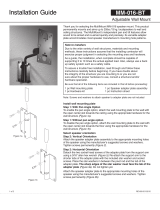
- 2 -
• English
Operating and Installation Instructions 1.0SI SERIES P10
General Notes on Safety
for Loudspeaker Systems
Mounting systems may only be used for those loudspeaker systems authorized by the
manufacturer and only with the mounting accessories specified by the manufacturer in the
installation instructions. Read and heed the manufacturer’s installation instructions. The
indicated load-bearing capacity cannot be guaranteed and the manufacturer will not be
liable for damages in the event of improper installation or the use of unauthorized mounting
accessories.
The system’s load-bearing capacity cannot be guaranteed and the manufacturer will not be
liable for damages in the event that loudspeakers, mounting accessories, and connecting and
attaching components are modified in any way.
Components affecting safety may only be repaired by the manufacturer or authorized agents,
otherwise the operating permit will be voided.
Installation may be performed by qualified personnel only, and then only at
pick-points with sufficient load-carrying capacity and in compliance with local building
regulations. Use only the mounting hardware specified by the manufacturer in the
installation instructions (screws, anchors, etc.). Take all the precautions necessary to ensure
bolted connections and other threaded locking devices will not loosen.
Fixed and portable installations (in this case, speakers and mounting accessories)
must be secured by two independent safeties to prevent them from falling. Safeties must be
able to catch accessories or parts that are loose or may become loose. Ensure compliance
with the given national regulations when using connecting, attaching, and rigging devices.
Factor potential dynamic forces (jerk) into the equation when determining the proper size
and load-bearing capacity of safeties.
Be sure to observe speaker stands’ maximum load-bearing capacity. Note that for
reasons of design and construction, most speaker stands are approved to bear centric loads
only; that is, the speakers’ mass has to be precisely centered and balanced. Ensure speaker
stands are set up stably and securely. Take appropriate added measures to secure speaker
stands, for example when:
- the floor or ground surface does not provide a stable, secure base.
- they are extended to heights that impede stability.
- high wind pressure may be expected.
- there is the risk that they may be knocked over by people.
Special measures may become necessary as precautions against unsafe audience behavior.
Do not set up speaker stands in evacuation routes and emergency exits. Ensure corridors are
wide enough and put proper barriers and markings in place when setting speaker stands up
in passageways. Mounting and dismounting are especially hazardous tasks. Use aids suitable
for this purpose. Observe the given national regulations when doing so.
Wear proper protection (in particular, a helmet, gloves, and safety
shoes) and use only suitable means of ascent (ladders, scaffolds, etc.) during installation.
Compliance with this requirement is the sole responsibility of the company performing the
installation.
WARNING! After installation, inspect the system comprised of the mounting fixtures
and loudspeakers to ensure it is properly secured. The operator of loudspeaker systems
(fixed or portable) must regularly inspect or task a third party to regularly inspect all system
components in accordance with the given country’s regulations and have possible defects
repaired immediately. We also strongly recommend maintaining a logbook or the like to
document all inspections.
Also be sure to provide sufficient safety margins for the rigging points used for flown
systems. Observe the given national regulations when doing so.
Professional loudspeaker systems can produce harmful volume levels. Even prolonged
exposure to seemingly harmless levels (starting at about 95 dBA SPL) can cause permanent
hearing damage! Therefore we recommend that everyone who is exposed to high volume
levels produced by loudspeaker systems wears professional hearing protection (earplugs or
earmuffs).
Manufacturer: Stamer Musikanlagen GmbH, Magdeburger Str. 8,
66606 St. Wendel, Germany
Version 2.8 08/2019
• Please keep these instructions for later use during installation or
make them available to the specialist company carrying out the
installation!
• The use of threadlocking adhesives is recommended for all screw
connections in order to guarantee a stable connection in the long
term.
• In principle, a suciently load-bearing surface and a suitable
connection method must be ensured for all installations. This
is the responsibility of the specialist company carrying out
the installation. In case of doubt, qualified advice (e.g. from
engineering consultants/staticians) must be sought.
• All loudspeakers must be inspected for damage and signs of wear
at regular intervals appropriate to the respective installation
site and its environmental conditions. This applies especially to
installations outside protected premises and in particular under
demanding environmental conditions.
• Examples of possible damage or signs of wear include the ingress
of water or dust into critical areas of the enclosure such as the
electrical connections or the mechanically sensitive areas of the
transducers, rust or mechanical damage to the metal surfaces/
grids/screws, and cracks or other damage to the paint finish.
• If damage of this or similar nature is found, the speaker must be
dismantled and repaired.




















